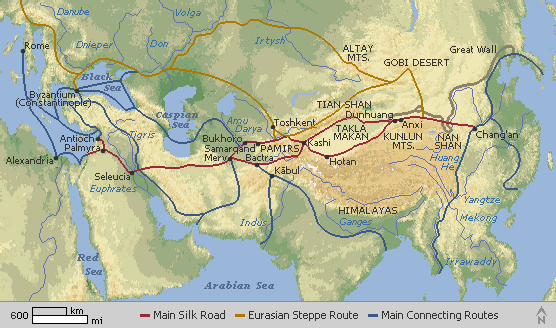 |
| National Silk Museum, Hangzhou |
I took a taxi through a couple of tunnels to the National Silk Museum on Yuhangshan Lu, up the hill from the southern end of West Lake. The museum is free; after my driver dropped me at the foot of the steps I walked straight into an almost empty modern and spacious exhibition hall, finding silk worms, fat, white caterpillars about 5 cm long, crawling around in a display case crammed with mulberry leaves. It takes 30 days from egg to silk. The smallest grubs, emerging from the hundreds of eggs laid by each female moth, are black; they turn gradually whiter as they fatten, sloughing off skins. They spin their cocoons onto a nest of sticks which is the point at which the silk fibres can be harvested, traditionally by hand, the ladies making a sort of glove out of them that they dip in water to wash. Eventually the pretty, silky white moths free themselves from the cocoons, mate with the males, lay their many eggs and promptly die. Fascinated, I watched this process on video.
 |
| At the museum: silk worms on mulberry leaves |
I saw several displays about the Silk Road, used from the 5th century BC, stretching all the way from China to Syria, to Turkey, to Hungary. Some of the "road" was across the ocean, to Madras and Arabia, even to Somalia, the Philippines and Rome. The bales of silk were either carried by camel or transported on ships such as the 12th century one I saw a model of; these vessels were 24 metres long, with 13 cabins.

There are as many as fourteen main types of silk cloth, including gauze, chiffon, crepe, brocade, velvet ... Different shuttle patterns in the weaving too, tabby, twill, satin, etc. Looms have been found near here by archeologists, their ornaments 4000 years old or more. I saw examples of the different kinds of dyeing. To decorate the cloth, they used wax or ash (if wax was scarce) and tie-dyeing techniques. Styles of embroidery and types of stitch were regional, though the subjects didn't differ much: cranes, dragons and winged horses. These "auspicious symbols" are still to be seen all around Hangzhou, engraved on paving stones on the side walks for instance, expressing "people's yearn for a well-being life," as the info board at the silk museum quaintly puts it. Bats, lions, peonies and the Chinese character meaning longevity. By the time the Qing Dynasty came along, the Chinese were also exporting silk in patterns created for western tastes (e.g. "greater western flowers" for Louis XV's mistresses in France). The tiny embroidered silk shoes, for the Qing Dynasty ladies' and children's bound feet made me feel sad.
 |
| Mulberry bushes at the silk museum |

No comments:
Post a Comment